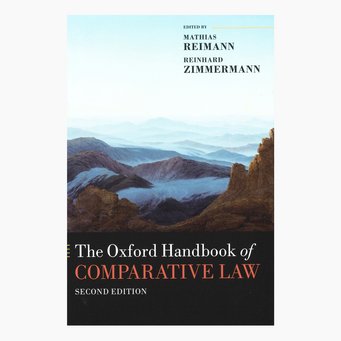“The Oxford Handbook of Comparative Law” published in a second edition
Private Law Gazette 2/2019 - The roots of comparative law reach back to antiquity. Comparative approaches to law have existed since long before the advent of the modern academic discipline – for example, in Ancient Greek philosophy of the state. Comparative law has gained increasing significance in the early twenty-first century. In the era of globalisation and amidst the harmonisation of private law in Europe, it is more relevant than ever. The “Oxford Handbook of Comparative Law”, published in 2006, provided a ground-breaking critical overview of the worldwide state of development of comparative law. Now the Handbook has been updated and expanded into a second edition published at the beginning of 2019.
The volume, edited by Reinhard Zimmermann, Managing Director of the Max Planck Institute for Comparative and International Private Law, together with Mathias Reimann, Hessel E. Yntema Professor of Law at the University of Michigan, is a compendium of contributions by 48 internationally prominent authors, including Emeritus Director Hein Kötz, Emeritus Director Klaus J. Hopt, and Institute Director Ralf Michaels.

“In the twelve years since publication of the first edition, comparative law has made rapid advancements as an academic discipline. This has been fuelled by an intensive discourse on methodology and a very considerable broadening of the thematic spectrum. From tackling the substantial challenges of legal unification to undertaking interdisciplinary projects, we are engaged in a multi-faceted field that is of steadily growing importance for both students and researchers”, says Reinhard Zimmermann.
Alongside its analysis of comparative methods and its presentation of links to other research areas, the new edition has been expanded to include five new chapters, featuring contributions about new directions in comparative law as well as about comparative law in the area of human rights and in the context of European Union law. The first edition’s chapter on East Asia has been replaced with two new chapters that treat China and Japan separately. An additional new chapter is dedicated to the role of comparative law in legal education.
As with the first edition, the Handbook is divided into three main sections. The first of these deals with global developments in comparative law and offers a current overview, encompassing France, Germany, Italy, the UK, and central and eastern Europe, as well as the US, Latin America, China and Japan.
The second section examines the most important comparative approaches, including their methods and goals, along with the relationship of comparative law to other disciplines such as legal history, economics and linguistics.
In his entry on the functional method of comparative law, Ralf Michaels explains that the notion of functionality is imprecise and that the functional method could indeed be improved. He nevertheless comes out in favour of – methodologically exacting – functionalist comparison. Significantly, in ascertaining functional equivalence, one is able to analyse not only the functionality of different laws but also their cultural mooring.
Reinhard Zimmermann examines in his article the significance of comparative law for the development of the private law within the European Union. His inquiry traces an historical arc, taking as a starting point the 1910 International Congress for Comparative Law in Paris, whose initiators strove for a unification of the law of modern nation states, moving forward to the establishment of UNIDROIT and UNCITRAL and the European Law Institute (ELI), and then continuing to the attempts by the European Commission to codify a uniform European contract law. He concludes with a look beyond the EU horizon, recalling a central aim of comparative research: overcoming intellectual boundaries.
The third section takes stock of comparative research in about a dozen areas, from private law to public law and criminal law. By joining together thematic diversity with methodological depth, the work lays new scholarly foundations and provides impetus for the agenda of the coming years in research, teaching, and legal development.












